Monday, May 27th 2019

AMD Announces Radeon RX 5700 Based on Navi: RDNA, 7nm, PCIe Gen4, GDDR6
AMD at its 2019 Computex keynote today unveiled the Radeon RX 5000 family of graphics cards that leverage its new Navi graphics architecture and 7 nm silicon fabrication process. Navi isn't just an incremental upgrade over Vega with a handful new technologies, but the biggest overhaul to AMD's GPU SIMD design since Graphics CoreNext, circa 2011. Called RDNA or Radeon DNA, the new compute unit by AMD is a clean-slate SIMD design with a 1.25X IPC uplift over Vega, an overhauled on-chip cache hierarchy, and a more streamlined graphics pipeline.
In addition, the architecture is designed to increase performance-per-Watt by 50 percent over Vega. The first part to leverage Navi is the Radeon RX 5700. AMD ran a side-by-side demo of the RX 5700 versus the GeForce RTX 2070 at Strange Brigade, where NVIDIA's $500 card was beaten. "Strange Brigade" is one game where AMD fares generally well as it is heavily optimized for asynchonous compute. Navi also ticks two big technology check-boxes, PCI-Express gen 4.0, and GDDR6 memory. AMD has planned a July availability for the RX 5700, and did not disclose pricing.
In addition, the architecture is designed to increase performance-per-Watt by 50 percent over Vega. The first part to leverage Navi is the Radeon RX 5700. AMD ran a side-by-side demo of the RX 5700 versus the GeForce RTX 2070 at Strange Brigade, where NVIDIA's $500 card was beaten. "Strange Brigade" is one game where AMD fares generally well as it is heavily optimized for asynchonous compute. Navi also ticks two big technology check-boxes, PCI-Express gen 4.0, and GDDR6 memory. AMD has planned a July availability for the RX 5700, and did not disclose pricing.
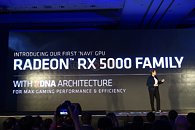
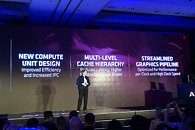
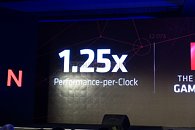
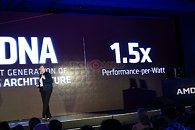
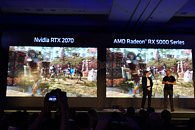
202 Comments on AMD Announces Radeon RX 5700 Based on Navi: RDNA, 7nm, PCIe Gen4, GDDR6
Remember AMD/RTG is setting itself up against a huge onslaught, and not just Nvidia or Enthusiast Gaming market which is just a pittance for profits. Compared that to what they might miss-out on if Intel makes strides into all these various emerging markets, while even later unlocks consoles and delivers their own true APU's. My hope is the Raja and all these other folks that were "brought-in" by Intel where compartmentalize, and didn't have full-understanding to the vision Lisa Sue (upper management) developed since mid 2016, but I think AMD has had such strategic overview compromised.
www.pcgamesn.com/intel/gpu-hires-amd-nvidia
So, no numbers on the 5700, it sounds like it will be another boring launch.
AMD has the disaster of old GCN cards getting into new series, RX500 vs RX400, etc.
Nvidia has the G92 fiasco (9 cards?), the 100, 300 and 800 series, and 90% of their mobile chips.
Intel has 4 series of CPUs with exactly the same IGP, they only added an U to the start of the name.
VIA is the only good guy here.
AMD routinely does stuff like: en.wikipedia.org/wiki/AMD_Radeon_Rx_200_series#Chipset_table (i.e. everything from Terrascale to GCN 1.3, all under the 200 moniker).
The new ground they could be breaking is Navi chips actually being from different families if the above rumor is true: little Navi built with GCN blocks, big Navi without.
Nvidia has been having a good conduct lately, doesn't mean they are innocent.
What maters is if the product is good, internally it could be an Intel IGP for all I care.
GCN is an instruction set that is not getting dropped any time soon, definitely not sooner than nVidia drops its 11 years old CUDA.
As for "microarchitectures" AMDs' own Vega is quite different to Polaris.And 2080 is compatible with 11 years old CUDA.
And, wait for it, Zen2 is compatible with 39 years old x86!!!
AMD just cannot innovate!Beating 2070 when overclocked + overvolted:
What trickery is this? How dare they sell us slower cards for cheap?
CUDA has a lot of driver optimization work, the ISA could be different between generations, Nvidia does the work to unify them in CUDA. You know, it's just another compute language.